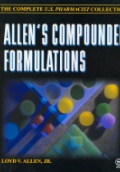Handbook of Pharmaceutical Manufacturing Formulations, 6 Vol. Set
Niazi S. K.
ISBN: 0849317525
Vydavatelství: CRC Press
Rok vydání: 2004
Původní cena: 0 Kč
Cena:
Na vyžádání
Nárok na
dopravu zdarma
Termín dodání na naši pobočku v Brně je přibližně 3-4 týdny.
